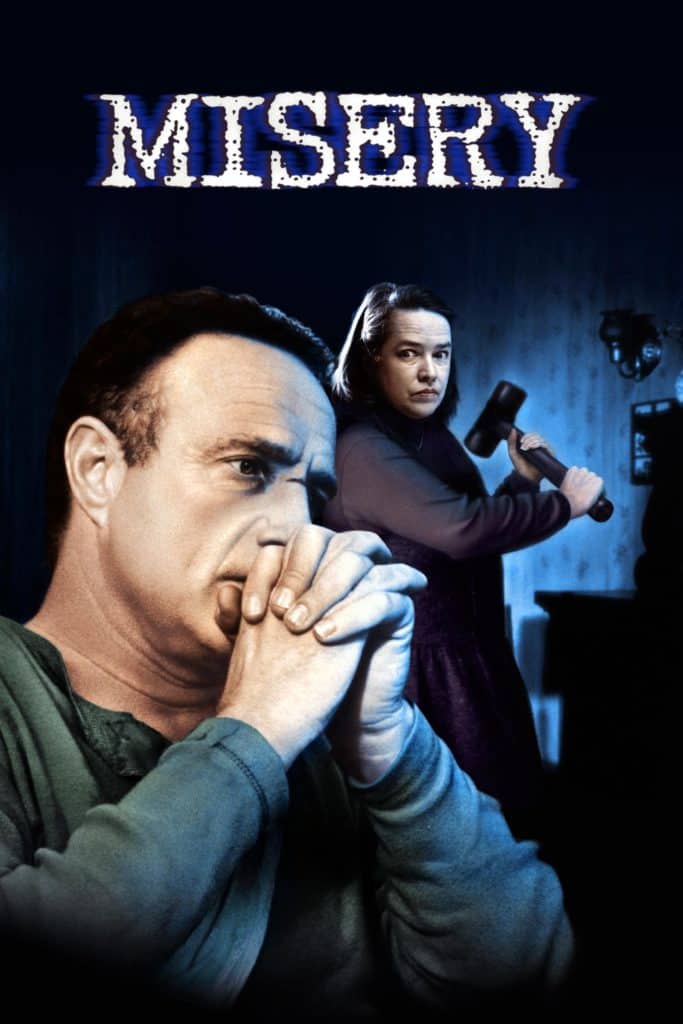My students tell me that one of the most powerful components of my 1-Step-A-Day Screenplay course is Step 7 “Story Architecture: 45 Elements To Build A Great Screenplay”.
Story Architecture is my technique to analyze, understand and write the 3 Act Structure.
It’s an Act by Act breakdown of the 45 elements your screenplay needs to fulfil the 3 Act Structure, be engaging, surprising, build coherently and express the complexity of your story and characters.
However, it isn’t a strict formula, you don’t have to include all of the elements, some scenes may have multiple elements in them, and they don’t have to appear in this order.
Here are the first 15 elements of Act 1. Importantly, to further explain these, I have broken down the film Misery into this format.
Act 2 and 3 are available in my 1 Step-A-Day training program. For more information please visit my membership page.
Act 1 Story Architecture Elements 1-15
Summary
1. Introduce Protagonist
2. Create Empathy
3. Set Tone
4. Introduce Theme
5. Skills & Abilities
6. Introduce Antagonist
7. Inciting Incident
8. First Step
9. Avoidance
10. Introduce Supporting Characters
11. Subplot Scenes
12. First Set Back
13. Set Up Climax
14. Backstory
15. Act 1 Climax
Misery
Screenplay by
William Goldman
Based on novel by
Stephen King
Logline
When a famous author crashes his car he is rescued by a fan of his novels, but he comes to realize the care he is receiving is only the beginning of a nightmare of captivity and abuse.
1. Introduce Protagonist
Opening image of the protagonist and what their current world and situation is.
Misery
Paul Sheldon, secluded in a mountain hotel, finishes writing his most personal novel. He is dressed in casual clothes with a slight retro feel which is complimented by his old leather briefcase. After completing his novel he is happy and satisfied.
2. Create Empathy
To become emotionally invested in the story the audience needs to empathize with the protagonist.
Tricks to create empathy are: Misfortune, Power, They Are the Best, Humour, Other Characters Admire Them, Powerful.
Misery
Misfortune
Paul dies in a car crash and despite being revived he is so seriously hurt he can’t walk, feed himself and is in incredible pain.
The Best
He’s a successful novelist
Other Characters Admire Them
Annie admires his skills as a writer deeply
The hotel owner where he writes his books refers to him as the perfect guest who is quiet, respectful and keeps things in order, it shows success hasn’t gone to his head.
Humor
He has a dry and self-deprecating sense of humor
3. Set Tone
Set the tone your story with some scenes that fulfil the experience the audience is expecting from the genre your story is.
If your screenplay is a Comedy – have some laughs, a Thriller – have a race against time or risky situation, an Action – have a chase or fight , a Horror – home some scares, a death or a haunting.
Misery
Is a thriller with horror elements. The tone is set in a few key moments.
The 2nd scene where Paul is driving in the snow storm has high risk.
Paul’s body, particularly his legs, are grotesquely damaged from the crash.
Annie seems to be lying to Paul so we are fearful for him and suspect her true nature is dangerous.
Paul wakes in the middle of the night and is startled by Annie towering over him in the dark.
4. Introduce Theme
Is the story about Justice, Survival, Love, The American Dream.
Is the theme a question to be explored – Can men and women be friends?
A moral – Crime doesn’t pay!
Misery
The screenplay explores themes of creative writing, obsessive crazed fans, mental illness and love. All are introduced in Act 1 and explored throughout the story.
A metaphorical theme is addiction as Stephen King wrote the novel when he was a cocaine addict. Annie represents cocaine. She eases the pain, pretends to care by making Paul feel good but ultimately, she’s a monster that’s imprisoning him and is dangerous to his health, relationships and life. This metaphor is touched upon in the screenplay but in much greater depth in the novel.
5. Skills & Abilities
Show some of the specific skills or abilities the protagonist has that they’ll need later in the story.
Misery
Paul is a talented writer and novelist. This is integral to the whole premise of the story and he will have to write to save his life.
He is skillful with his hands and has good hand eye coordination. He lights a match with the flick of his thumb like a cowboy in an old western and he throws a snowball at a distant tree hitting it. These skills become vital in Act 2 & 3.
6. Introduce Antagonist
Opening image of them and what they are doing.
Misery
Annie Wilks is the Antagonist. Her first appearance is saving Paul but she is a mysterious figure, we don’t learn her identity but see her skills as she resuscitates Paul and is physically strong. The first real look we get of her is nursing Paul when he regains consciousness in her house. She is dressed matronly, wears a cross, explains she’s a nurse and her demeanor is caring and compassionate. She details the seriousness of his injuries but assures him he’s in good hands and it’s her honor to nurse him back to health.
7. Inciting Incident
The event that throws the protagonists world out of balance which sets up the goal of the story they strive to achieve. From the inciting incident emerges the Dramatic Question which must be answered by the end of the story.
Misery
Paul Sheldon leaves the hotel in his Dodger when a snow storm hits, he’s driving erratically and crashes. He dies in the car wreck but is dragged out and revived by a mysterious person.
Misery’s Dramatic Question is
Will Paul survive the crash?
The Dramatic Question escalates as the story progresses to
Will Paul survive his imprisonment by Annie?
8. First Step
If the protagonist chooses, is forced to engage or react to the inciting incident, what is the First Step they take to achieve their goal or solve their problem?
Misery’s screenplay holds off using this element as Paul isn’t aware of the true nature of his situation in Act 1. This element appears in Act 2.
9. Avoidance
If the protagonist doesn’t react or refuse to engage how and why do they do this?
Again, Misery’s screenplay doesn’t use this element as Paul isn’t aware of the true nature of his situation in Act 1 and, when he becomes aware, he immediately instigates a plan.
10. Introduce Supporting Characters
Introduce some of the supporting characters, though not all have to be introduced in Act 1.
Misery
The flashback in scene 4 introduces Paul’s agent. When Paul goes missing, she instigates the search for him which in turn introduces another supporting character, Buster the Sheriff.
11. Subplot Scenes
Commence a subplot.
Misery combines this element with element 10.
The subplot of Misery is local sheriff Buster’s search for Paul Sheldon. The inciting incident for the subplot is when Paul’s agent calls Buster worried that Paul hasn’t been seen for a few days. Buster starts to investigate, his goal is – To find Paul.
12. First Set Back
What is the first set back the protagonist encounters in striving to achieve their goal?
Misery
This is subtle as Paul’s goal in Act 1 is to notify his daughter and agent that he is alive. Annie tells Paul she’ll call the moment the phone lines are restored and the roads are open after the storm. When she later slips that she drove into town to get Paul’s latest Misery novel, she lies to him that the hospital said as long as he’s stable he can remain in her care and she called his agent and daughter from a town phone as they have been repaired but her home phone is still down. Paul starts to become suspicious.
13. Set Up Climax
Show any specific elements for the climax to work.
Misery
The opening scene is Paul finishing his novel and he indulges in his customary ritual of smoking a cigarette and having a glass of Dom Perignon to celebrate completion. This ritual becomes crucial for Paul achieving his goal in the Story Climax.
14. Backstory
What is part of the protagonist’s back story?
Misery
As Paul lies dying in his car wreck, the screenplay flashbacks to Paul in his agent’s office talking about how he feels he’s sold out by writing the Misery novels. They are a huge success and have made him rich and famous but he’s creatively and emotionally dissatisfied with them. His next novel (which he finishes at the start of the film in the Introduce Protagonist scene) will be his most personal and something he can be proud of.
15. Act 1 Climax
A point of no return, committing to the goal, a major set back, a major development, a revelation, a transition to new world – is it positive or negative event?
Misery
In the middle of the night Paul is woken by a furious Annie. She has just got to the part in his latest Misery novel where Misery Chastain dies. Paul tries to explain why he killed the character off but Annie flies into a rage and tells him she never called his agent, daughter or the hospital and he is her prisoner. She drives away and Paul painfully falls out of bed and crawls the length of the room to discover the door is locked.
The Act 1 Climax is a negative development.

Free Download:
How to write your Dream Screenplay using the 1-Step-A-Day technique
Discover the step-by-step proven method to write your Screenplay even if you’ve tried and failed before.




